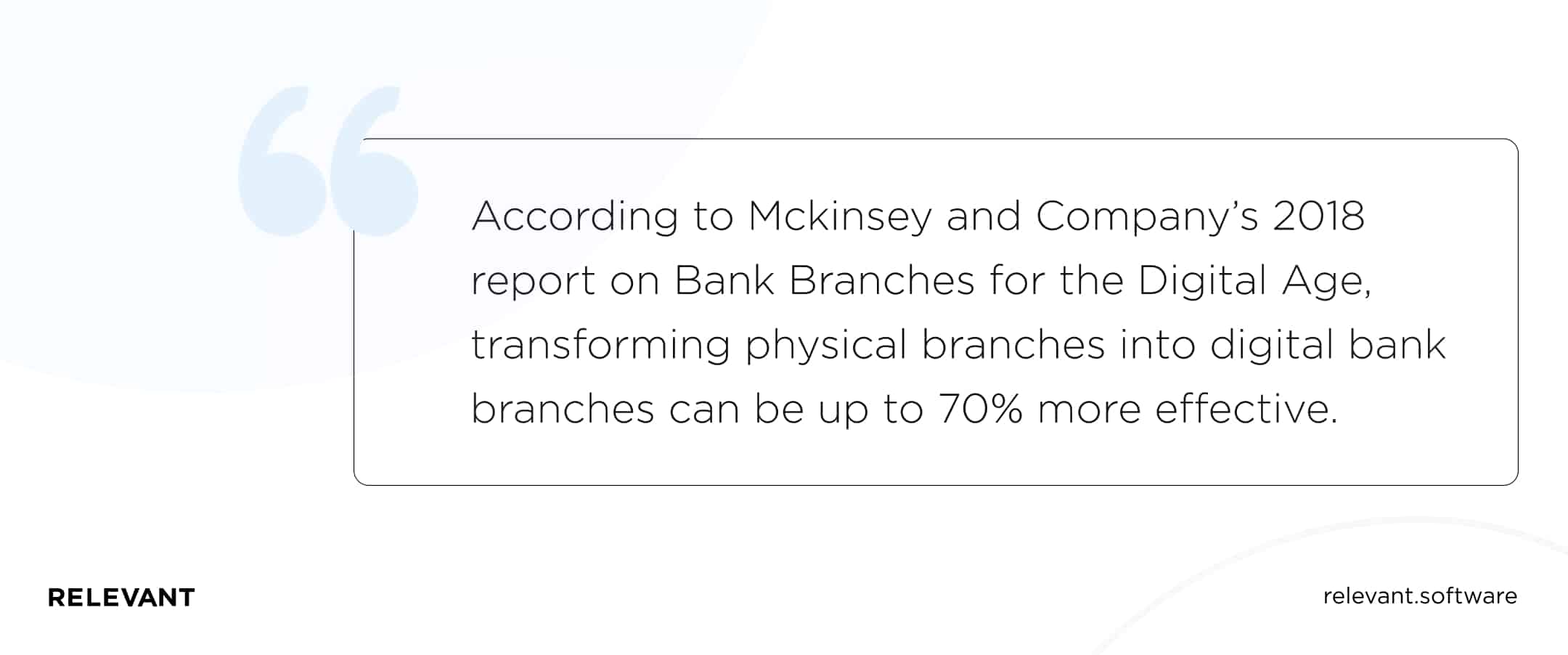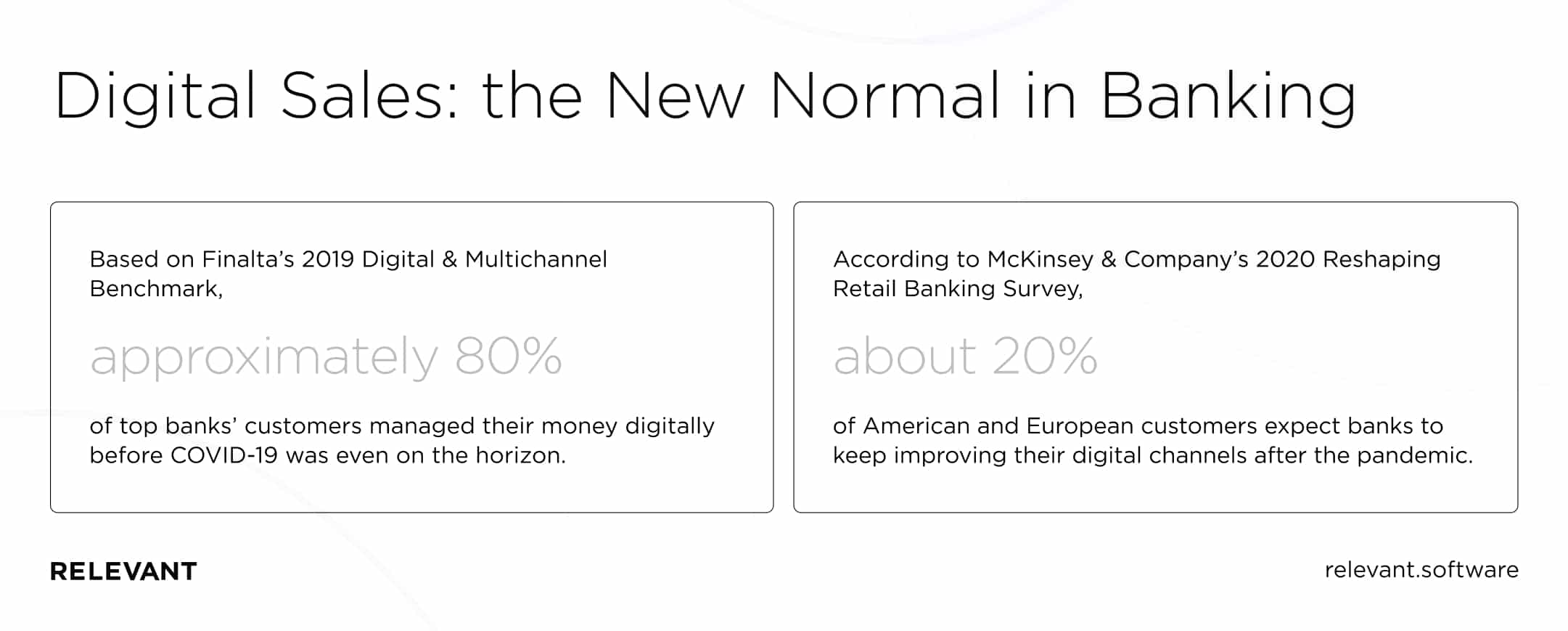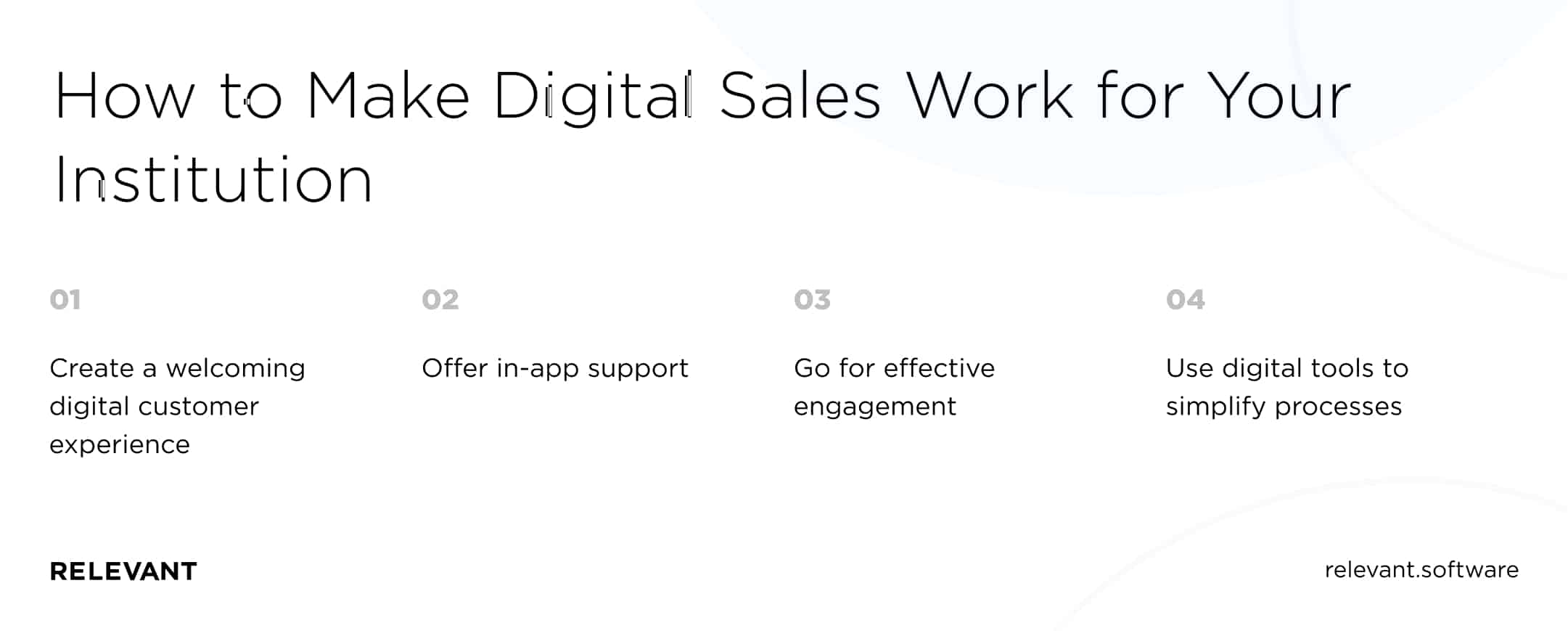Digitalization of Sales Channels and Implementation of Digital Branch Solutions in Banking
Updated: May 20, 2021
Banks are moving from an interruptive marketing strategy to a customer-centric approach and smart banking. This trend existed long before the COVID-19 crisis. But the pandemic has made physical interactions more difficult, accelerating the ongoing digital transformation of bank branches. Although many of these changes were forced, they resulted in numerous benefits for financial institutions.
According to Mckinsey and Company’s 2018 report on Bank Branches for the Digital Age, transforming physical branches into digital bank branches can lead to significant cost-saving and an increase in revenue. With the right software, bank branches can be up to 70% more effective.

We provide companies with senior tech talent and product development expertise to build world-class software. Let's talk about how we can help you.
Contact us
Relevant provides world-class outsourcing and fintech software development services. Our team can help you adopt the best digitalization practices by developing custom branch solutions tailored precisely to your institution’s needs.
This article will discuss the importance of digital branch banking and explain how smart banking can elevate your sales performance.
Table of Contents
Digital sales: the new normal in banking
Traditional branches were in decline long before the global pandemic. Based on Finalta’s 2019 Digital & Multichannel Benchmark, approximately 80% of top banks’ customers managed their money digitally before COVID-19 was even on the horizon. Forward-looking banks and credit unions started seeing digital sales as an opportunity decades ago.
To meet the market demand, many of them did more than just add a few new features to their banking apps. Industry leaders have transformed their existing approach into an entirely new business model with digital bank branches specifically focused on meeting customer needs.
The COVID-19 outbreak has pushed this transformation towards digital solutions even further. According to McKinsey & Company’s 2020 Reshaping Retail Banking Survey, about 20% of American and European customers expect banks to keep improving their digital channels after the pandemic.
Today, digital sales and smart banks are no longer considered innovative. They’re the new normal. For banks that haven’t prepared their digital bank branches for the future yet, now is an excellent time to learn from other’s success.

The digital stack’s role in bank sales
Transformation towards digital-first bank branches can help financial institutions to increase sales in various ways. Let’s take a look at two hypothetical customer journeys so you get a better picture of how it works.
George and Deborah’s banking matters
Let’s imagine George wants to print a financial statement at the self-service terminal system (SSTS). Upon accessing the terminal, the analytical model detects George as a small business owner with steady revenue.
After printing the financial statement, the terminal displays an offer to open a business account. George accepts and uses the SSTS to schedule a meeting with a banking associate. The next day, George opens a new account from home via video conference. There, he uploads his scanned documents and signs a contract with an electronic signature.
In another case, Deborah uses the bank’s mobile app to pay off loans she received from a different bank. The analytical model checks her credit score, monthly income, and preferred communications method. The system also takes note of Deborah’s favorite coffee shops and online stores.
Next, the app sends a pop-up notification offering Deborah a new credit card on favorable terms with a low-interest rate. And the icing on the cake, the bank even offers cashback rewards when she pays in her favorite shops. Deborah accepts the offer and uses the mobile app to customize the card’s design and orders it to be delivered. Meanwhile, the card automatically appears on her account.
As you can see, the bank managed to predict customer’s needs to provide services they could really use. In George’s case, the system even managed to convert a low-value transaction into a high-value deal. Now, what role does the digital stack play in both examples?
How digital-first bank branches help banks upsell their services
The digitalization has affected George and Deborah’s customer journeys on several tiers. Let’s analyze each of them:
- Data. This tier collects information about customer behavior on internal and third-party digital channels. For instance, the bank sees George’s and Deborah’s incomes, credit scores, and products they’re interested in.
- Analytics. AI and machine learning technologies look for offers that George and Deborah might find helpful.
- Marketing. The analytical model detects Deborah’s favorite communication method (messaging apps, SMS, emails) to personalize her offer. George receives a proposal right after he finishes his business (printing a statement).
- Engagement. The software factors in the optimal time to interact with the user. If Deborah didn’t click on the pop-up notification right away, the system would have sent an offer via email and WhatsApp messages over the next few weeks. As for George, the SSTS allowed him to set a meeting at a convenient time.
- Fulfillment. George opens a business account through a conference call, and Deborah orders a card via the mobile app.
The stories we described above perfectly capture how digitalization can enhance sales. That doesn’t mean banks should implement these exact solutions, but they’ll have to rethink their business models to meet customer’s needs more efficiently.
Four ways to make digital sales work for your institution
According to Mobiquity’s 2021 Digital Banking Report, over 40% of customers would switch banks to get better digital tools. And the thing about smart banks—they are quick and easy to sign up for. Switching won’t be hard because users can upload scans of their ID, apply an electronic signature, and order a card within minutes.
To optimize your digitized banking service, you should place the customer at the center of your digital transformation and financial app development.
Here are some recommendations you may want to follow during this process.

1. Create a welcoming digital customer experience
Retail banks’ customers should always feel welcomed. How do you achieve this? Some best practices include:
- Fast registration. It is one of the most effective ways to attract new customers to your bank.
- User-friendly design. It will help users navigate through your solutions.
- Biometric authentication. It will ensure fast and convenient access to the online service.
- Digital signatures. It will reduce paperwork and enable easy and seamless transactions.
- Automated reports. They will allow customers to create business statements at a preset time or in intervals.
- Screen sharing technology. It can replicate the advantages of in-person interactions.
- Gratification techniques (such as celebratory music after a successful transaction). They can make the process more pleasurable.
- Digital self-service. It allows users to quickly resolve issues on their own.
You can also enhance your offering by partnering with merchants and marketplaces. For example, users can receive discounts or cashback when paying for goods or services via your app or card.
Another key goal is to make your customers feel that your company is always ready to assist them. You can make this possible with digitals tools and customer support.
2. Offer in-app support
Direct support is crucial as bank accounts become increasingly digital and customers perform many transactions themselves. In general, in-app customer support can be delivered in multiple formats:
- AI-powered chatbots can help customers with basic operations and navigation
- Interactive voice response (IVR) with contextual awareness can provide tailored responses to customers’ questions
- Curated messaging in the form of in-app insights and push notifications will help users learn more about an app as they use it
Despite these practical tools, businesses still need to have a customer support team. Ideally, users should be able to reach real operators via an app whenever they need to.
3. Go for effective engagement
Digital sales are about offering the right product to the right customers—when they need it and how they want it. To engage with customers more effectively, you can use the following solutions:
- Customer-relationship-management (CRM) tools. They use product descriptions, client behavior, and socio-demographic data to personalize offers.
- A multichannel contact tree. It allows bank representatives to communicate with the customer via their preferred digital channels.
- Advanced analytics software. It improves data collection and processing to tailor services to the needs of individual users.
A side note here, the integration of all systems is essential. But you need to remember that they will work with large volumes of personal information. So your IT ecosystem must include a reliable fintech app security solution to prevent data leaks.
Relevant can upgrade your software with the latest features, such as role-based access control, secure app logic, adaptive authentication, military-grade data encryption, and tokenization. Our dedicated software development teams can also implement cybersecurity into the core of the development process.
4. Use digital tools to simplify processes
Customers want advanced services to be at their fingertips. You can implement most simple transactions with apps or other solutions. Some of the functionality people expect from digital banking tools are:
- Fund management
- Money transfers
- Loans
- Insurance
- Taxpaying
- Paying fines
- Reviewing statements
- Querying transactions
Many high-value financial transactions can’t be entirely online. Customers still need to visit bank branches to get a mortgage, withdraw large sums of money, or close a huge deal.
But your aim should be to make even complex transactions like that feel effortless. At the same time, less tech-savvy customers must be able to find support if they face a challenge. Both of these goals could be achieved by creating digital bank branches.
Smart digital branches
Digital branches should offer a unified customer experience and, ideally, 24/7 access for complex interactions. Here are the key solutions that can make this possible.
- ITM (interactive teller machine). ITMs allow customers to access core functions and connect to bankers outside of physical branches. These machines come with scanners, authenticators, facial recognition software, and ID readers. Even less digitally literate people can use ITMs to receive bank cards and loans.
- Self-service terminal system (SSTS). These devices have fewer features than ITMs. Customers can use them inside and outside of bank branches to conduct simple transactions. SSTSs can also offer personalized offers during low-priority operations.
- Specialized banker tablet. Advanced tablets allow bank operators to access real-time data about customers and make offers on the spot.
- Robot greeter. According to CPG’s Two Customer Personas of COVID-19 White Paper, many customers expect pandemic-related restrictions to have a long-term impact. Robot greeters might be the best solution, offering tailored advice and touchless services.
- Interactive welcome screen. Welcome screens and walls offer an experience similar to ITMs, but with a better interface and more screen real estate for advertising.
- Video-conferencing machine. These devices are made for complex operations, such as mortgages and business-to-business deals. Many banks provide dedicated video conference rooms to help users get advice and update crucial business details in a secure environment.
These digital solutions can be possible with a centralized data system and advanced financial software. If you want to improve your platform or build it from scratch, you might consider hiring developers with relevant expertise.
Relevant is a Ukrainian outsourcing company that has experienced developers with qualifications in various programming languages, deep industry knowledge, and some of the most favorable rates.
Summary
Bank customers will continue to move toward digital tools. Although physical branches won’t lose their relevance altogether, it’s vital to reinvent bank branches for the digital age to attract more clients.
Financial organizations striving to keep up with the times should focus on digital sales. This means providing an omnichannel experience that links online, mobile, and physical branches into a seamless ecosystem with a personalized approach for every customer.
Do you want to enhance your sales with innovative solutions? Drop us a line to learn how we can guide your financial institution towards digital transformation.
Our core services:
Do you want a price estimate for your project?
Do you know that we helped 200+ companies build web/mobile apps and scale dev teams?
Let's talk about your engineering needs.
Write to us











